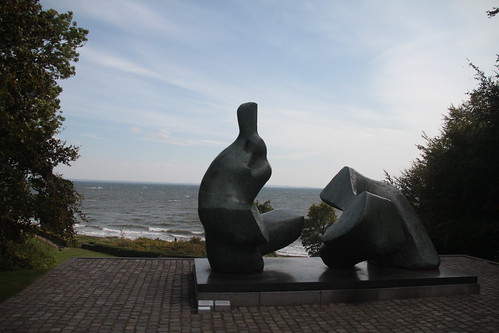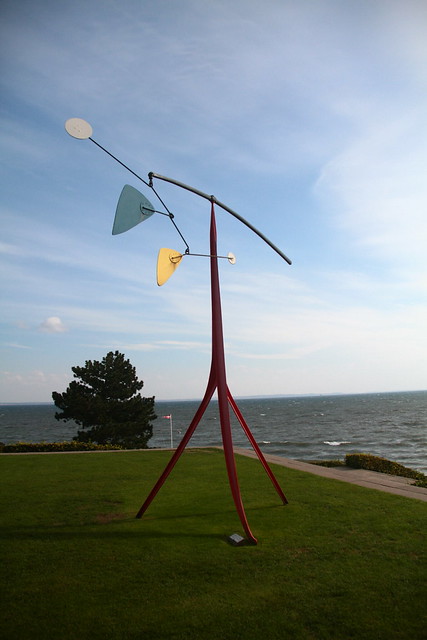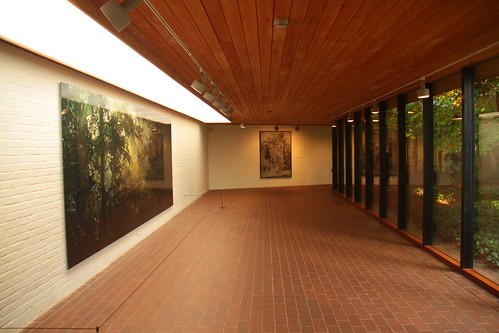The Louisiana Museum of Modern Art
Note: All photographs used in this post were taken by me, and I reserve all rights to them.
A couple of weeks ago, I visited the Louisiana Museum of Modern Art while I was in Copenhagen. It is easily one of my favourite places to visit. What struck me most about the museum was its use of space, especially in the Sculpture Park. This was an outdoor space in the museum grounds with sprawling lawns and a series of sculptures all set against along the harbour. The exhibition space combined landscape, architecture, sculpture and people in a manner that emphasised that all works of art here were a lived experience whose meaning created through the way in which people interacted with them. For me, this posed an interesting puzzle: three out of the four of these aspects of the museum I love photographing while the fourth, people, I absolutely revile. I never train my lens onto people, and while I may have some people feature incidentally in the shots of places I visit, I never deliberately take pictures of people. So I was at a loss as to how I could go about taking pictures of the museum in a way that adequately captured the essence of this exhibition space when I was so averse to taking pictures of one of its vital aspects.
_Henry Moore’s _Reclining Figure No. 5
The first work that stood out was Henry Moore’s Reclining Figure No. 5 on the far side of the sculpture park. This abstract figure, with the piece on the left representing the head and torso and the one on the right the extended legs, doesn’t, to my mind, convey a sense of ‘reclining’: there is a physicality to reclining — a body at rest, its weight supported by an elbow or whatever it is leaning against — that this abstract depiction doesn’t quite convey this because of how abstracted and atomised the body has become. The curve on the figure on the left feels like a bent back, and with nothing to lean against it suggests the strain of hunching rather than rest. But what made this figure engaging was its placement against the seaside view: it is in a place where I would have liked to recline and read. And people were flocking around the sculpture, sitting or even reclining on the grass adjoining it. Regrettably, all my attempts to photograph it left people outside the frame, as I was more concerned with the statue and its landscape than the way people responded to it.
_Alexander Calder’s _Little Janey-Waney
Just like how Moore’s reclining figure, Alexander Calder’s Little Janey-Waney also seems like it looks over the Øresund. This mobile is up on a terrace next to the café, alongside two of Calder’s other sculptures. It is named after ‘Baby’ Jane Holzer, actress, film producer and art collector at whose behest Calder made this mobile. I love how child-like this piece is with its bright, pastel colours and simple geometric shapes. It being a mobile, there is a sense of a toddler’s restlessness about its constant movement and rattling. Just like how I saw people reclining near the Moore sculpture, I’d like to imagine children playing around the foot of the Calder. I know, once again, the lack of people in my picture makes this work appear far too sterile, something I suspect Calder himself would have disliked.
Reflection
One of the things that I have always been wary of is how I am never in my photographs because I am the person who is taking them. The Louisiana is about an interaction with art and space, but at the same time none of my interactions with the landscape are ever visible in the photographs. This is why when I saw the strait reflected on the café windows, I toyed with trying to capture my reflection as I photographed the strait itself. The results were hardly compelling, but at the very least this is a nod towards trying to bring myself within the frame and draw attention to the perspectival nature of the shot.
_Thomas Demand’s _Lichtung/Clearing
Perhaps one work which exemplifies the interaction between the artwork and the landscape of the exhibition space is Thomas Demand’s Lichtung (‘Clearing’), a Diasec-mounted print of a clearing in a forest. From the pictures of the museum that I saw on-line, this work used to be on display in one of the viewing galleries, but during my visit was housed in a corridor opposite full-length windows looking out to the gardens. I like this because of the way in which the painting seems to reflect the view of the garden. Moreover, a Diasec mount involves having an image bonded directly to an acrylic sheet. Acrylic is clearer and has a higher light penetration than glass. So as evident in this picture, the picture of the clearing seems more vivid than the view of the garden through the window. Not only does the picture reflect the landscape, but it even presents the landscape in a way that is more striking than nature itself.
There were two exhibitions on at the Louisiana at the time, a major Marina Abramović retrospective titled The Cleaner, and a series of portraits by the photographer Rineke Dijkstra The One and the Many. Dijkstra’s portraits were especially remarkable for the way in which they captured a complex story of the subject in a single image. Through their postures, their interaction with unfamiliar environments, or through the marks or scars on their bodies or clothing, these figures gestured towards a story outside of that single moment. I couldn’t take any pictures to illustrate this. There was a series of portraits of new mothers whose bodies showed the scars and stretch marks of having given birth. There was a portrait of a matador covered in blood spatters having just fought a bull. There were children whose postures conveyed the tension in their arms and legs, as if they were going to break into dance or movement. My favourite was a series of portraits of three sisters over many years, showing their changing faces and hairstyles.
Dijkstra’s portraits made clear to me why I am so reluctant to take pictures of people, partly because I know I would never be able to take pictures that are nearly as good, but mostly because I don’t know how to elicit these kinds of responses from people. I don’t understand how people think, feel, act or behave well enough to know how to position them. I am much more comfortable taking pictures of objects or landscapes like the sculptures around the sculpture park, where the extent of my control goes only as far as my camera equipment, my perspective on the objects and my own movement within space, rather than having to interact with and direct another individual into a particular pose.
(For the full album of my pictures from Louisiana, go to my Flickr feed.)
Acknowledgement: My thanks to Katie Hawthorne for the recommendation to go to Louisiana. It certainly is one of the best places to visit in Copenhagen.



